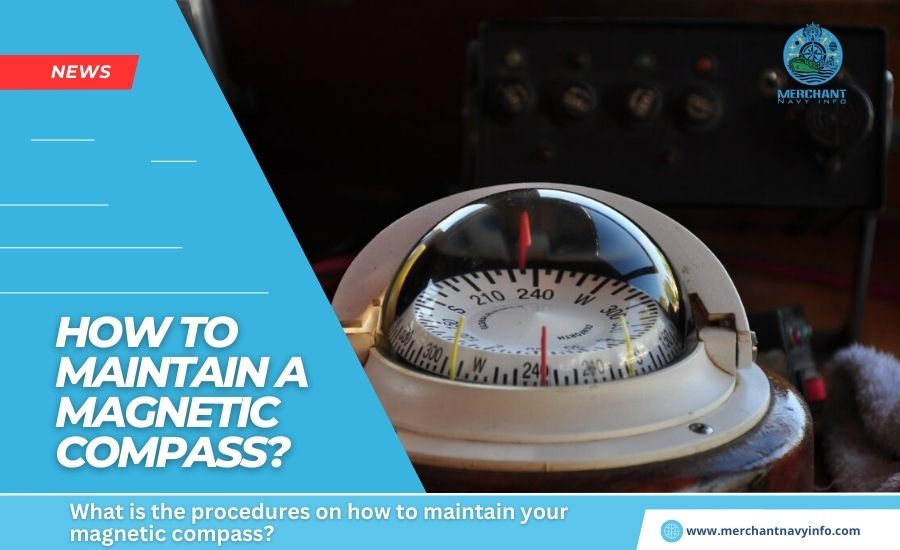
As per Chapter V, regulation 19 of the 2000 amendments to the 1974 International Convention for the Safety of Life at Sea (SOLAS) 1974. It is mandatory to use a magnetic compass that adheres to the standards set forth by the IMO. The Panama Ship Registry recently established guidelines for maintaining and testing magnetic compasses. Which applies to all ships irrespective of their size and navigation area. The Organization has developed standards for the maintenance of compasses on ships, which the owner/operator. The Master must follow to ensure that they are in good working order. It is the responsibility of the owner/operator and the Master to maintain the compasses on their ships in good working order according to these standards.
Effect of changes in magnetism during the life of a ship
New ships can experience unstable magnetism, affecting magnetic compass performance. It is essential to monitor and adjust as necessary. Especially when carrying magnetic cargo, using electromagnetic lifting appliances, experiencing a casualty, or during idleness.
Keep in mind
Electromagnetic equipment can induce magnetism that alters a compass’s accuracy on a ship. However, experts recommend against immediate readjustment as the induced magnetism decays over time. Regular observation and recording of compass deviation can detect errors and identify the need for repair, testing, or adjustment.
Adjustment and repairs
Adjustments A duly authorized compass adjuster must adjust. Suppose a qualified and certified compass adjuster is unavailable, and the Master considers it necessary. In that case, adjustmentMasterbe made by the Master, who should also have expertise as a compass adjuster
The Administration of Panama may also accept the compass adjusters recognized by one of the States members of the SOLAS 74 Convention. It also must complete a Compass adjustment course in a certified center that meets the International standards developed by the Organization. Under no circumstances shall the same person who surveyed a vessel carry out the compass adjustment. The date of any adjustment and other details should be noted in the compass deviation book.
Major things to consider
- The position of all compass correctors should be recorded in the compass deviation book and on deviation cards.
- The manufacturer of ship equipment such as Radar, Gyro compasses, Radios, etc. Determines the minimum distance required between the magnetic compass and electrical panels or any other electrical equipment. The Organization develops these standards and must be verified by the Flag State surveyors while surveying the ship.
- Prepare separate deviation cards for the standard compass and the transmitting magnetic compass repeater. You need to compare the headings.
- After adjusting the vessel, a certificate of compass adjustment with a deviation table is required. The certificate should contain the vessel’s name/IMO #/call letters/flag/place, adjuster’s name/stamp/sign, compass maker, sea/weather conditions, the method used, and numerical/graphical deviation results.
- Authorized companies should perform compass repairs using proper test facilities. The authorities should issue a certificate to the owner or Master after completing the repair, specifying that they have done the repair according to international standards.
Please ensure that you keep portable electrical equipment (such as radios, tape recorders, or steel items) away from the compass position, as they can affect its performance. We advise the Master and Officers to take necessary precautions.
Spare Bowl
Remember to carefully stow the spare magnetic compass bowl with its gimbal units away from the bridge structure. So that it remains unaffected by any casualty turning off the bridge.
Transmitting Magnetic Compasses (TMC)
If an existing or new magnetic compass designed to meet standards is changed to provide a transmission output. It must be recertified or certified with the transmitting element installed.
An experienced compass technician should make modifications to ensure that the transmitting element is compatible with the binnacle. Once the compass adjuster makes adjustments and recertifies the compass (as described above), we can rely on the equipment’s performance.
It’s important to ensure safe distances from the compass when modifying auxiliary equipment and avoid radio frequency interference. For guidance, refer to IMO Resolution A.813(19) and A.694(17). If using a transmitting magnetic compass, the spare bowl must be individually tested.









